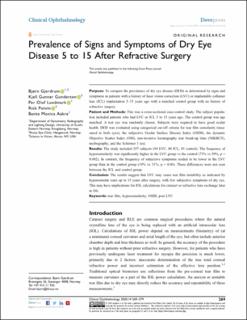| dc.contributor.author | Gjerdrum, Bjørn | |
| dc.contributor.author | Gundersen, Kjell Gunnar | |
| dc.contributor.author | Lundmark, Per | |
| dc.contributor.author | Potvin, Rick | |
| dc.contributor.author | Aakre, Bente Monica | |
| dc.date.accessioned | 2021-04-26T11:35:12Z | |
| dc.date.available | 2021-04-26T11:35:12Z | |
| dc.date.created | 2020-12-21T16:06:04Z | |
| dc.date.issued | 2020 | |
| dc.identifier.citation | Gjerdrum, B., Gundersen, K. G., Lundmark, P. O., Potvin, R., & Aakre, B. M. (2020). Prevalence of signs and symptoms of dry eye disease 5 to 15 after refractive surgery. Clinical Ophthalmology, 14, 269-279. | en_US |
| dc.identifier.issn | 1177-5467 | |
| dc.identifier.uri | https://hdl.handle.net/11250/2739577 | |
| dc.description.abstract | Purpose: To compare the prevalence of dry eye disease (DED) as determined by signs and symptoms in patients with a history of laser vision correction (LVC) or implantable collamer lens (ICL) implantation 5–15 years ago with a matched control group with no history of refractive surgery.
Patient and Methods: This was a cross-sectional case-control study. The subject population included patients who had LVC or ICL 5 to 15 years ago. The control group was age matched. A test eye was randomly chosen. Subjects were required to have good ocular health. DED was evaluated using categorical cut-off criteria for tear film osmolarity (measured in both eyes), the subjective Ocular Surface Disease Index (OSDI), the dynamic Objective Scatter Index (OSI), non-invasive keratography tear break-up time (NIKBUT), meibography, and the Schirmer 1 test.
Results: The study included 257 subjects (94 LVC, 80 ICL, 83 control). The frequency of hyperosmolarity was significantly higher in the LVC group vs the control (73% vs 50%, p = 0.002), In contrast, the frequency of subjective symptoms tended to be lower in the LVC group than in the control group (19% vs 31%; p = 0.06). These differences were not seen between the ICL and control group.
Conclusion: The results suggest that LVC may cause tear film instability as indicated by hyperosmolar tears up to 15 years after surgery, with few subjective symptoms of dry eye. This may have implications for IOL calculations for cataract or refractive lens exchange later in life. | en_US |
| dc.language.iso | eng | en_US |
| dc.rights | Navngivelse-Ikkekommersiell 4.0 Internasjonal | * |
| dc.rights.uri | http://creativecommons.org/licenses/by-nc/4.0/deed.no | * |
| dc.title | Prevalence of signs and symptoms of dry eye disease 5 to 15 after refractive surgery | en_US |
| dc.type | Peer reviewed | en_US |
| dc.type | Journal article | en_US |
| dc.description.version | publishedVersion | en_US |
| dc.rights.holder | © 2020 Gjerdrum et al. | en_US |
| dc.source.pagenumber | 269-279 | en_US |
| dc.source.volume | 14 | en_US |
| dc.source.journal | Clinical Ophthalmology | en_US |
| dc.identifier.doi | https://doi.org/10.2147/OPTH.S236749 | |
| dc.identifier.cristin | 1862454 | |
| dc.relation.project | Norges forskningsråd: 273006 | en_US |
| cristin.ispublished | true | |
| cristin.fulltext | original | |
| cristin.qualitycode | 1 | |

